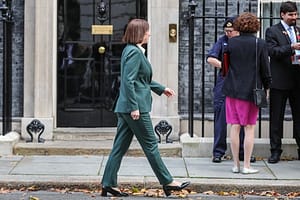The Chancellor will deliver his Autumn Statement on 22 November, this is the second major fiscal event of the year following the March 2023 Budget.
There are a number of features of this Statement for investors, savers and the financial markets to focus on:
- One, is the latest economic assessment from the Office for Budget Responsibility (OBR).
- Two, is how poor are the fiscal numbers, including what impact has inflation had on them as it will have squeezed the impact of existing government spending plans while boosting tax revenues. Thus, how much ‘fiscal space’ is there for the Chancellor to unveil new policy measures?
- Three, and what might these measures be?
The economy is slowing. Recession looks increasingly more likely, although not certain. The economic risks lie to the downside. In such an environment, the case for a fiscal stimulus is strong. Ironically, however, this economic outlook may limit the Chancellor’s room for policy manoeuvre. This is because the UK’s fiscal policy constraints are ‘pro-cyclical’ as opposed to counter-cyclical. That is in part because of how the fiscal rules and the debt and deficit numbers interact.
When growth is robust, they allow the scope for more fiscal stimulus. When growth is weak, as now, they constrain the “fiscal space”. If economic growth is expected to be weak then more of the existing budget deficit is viewed as “structural” as opposed to being cyclical. In turn that means there is less fiscal space and this constrains room for stimulus. The key, therefore, in terms of what the Chancellor can unveil is what the OBR is predicting for the economy.
Much market attention will be on how gilt yields respond. Bond yields have risen sharply in the last few years, largely in response to the spike in inflation and higher interest rates. Now, inflation is decelerating – although the level of consumer prices is far higher than pre-pandemic – and interest rates have probably peaked at 5.25%. Rate cuts will be likely in the second half of next year. This would suggest bond yields are at or close to their peak.
However, the oversupply in the bond market is unlikely to prevent yields from falling if the economy weakens. Yet one of the key determinants of the near-term bond market outlook will be its assessment of the Autumn Statement and its impact on the economy, bond issuance and policy.
Importantly, the Chancellor appreciates the importance of keeping the markets onside. His focus in the 2022 Autumn Statement was to stabilise the markets after the combination of the mini-budget and the LDI crisis.
This was at a time when the markets were worried about the lack of credibility of UK monetary policy and alarmed about UK inflation, which peaked at 11.1% last October. By the time of the March Budget, the Chancellor’s focus had switched from stability to growth. Even so, the markets were not caught unawares and were fully expecting the measures that were announced.
Currently, market expectations are that this will be a low-key Autumn Statement. Perhaps they may be surprised. Naturally, there is a huge political dimension surrounding this Statement. A general election must be held by January 2025, although many guess it could take place next autumn. If so, that leaves this Statement and the March 2024 Budget for the Chancellor to unveil new spending or tax measures.
Often, and perhaps nowadays one should say usually, Chancellors relax policy in the run-up to an election. Probably the last Chancellor to oversee a very tight fiscal policy going into an election was Labour’s Roy Jenkins ahead of the 1970 election. Then, Labour lost unexpectedly to the Conservatives.
The UK ran budget surpluses in both 1969/70 and 1970/71. Since then, there have been only five years when the UK has run budget surpluses, with government spending not exceeding revenues. These were 1988/89 and 1989/90 at the height of the Lawson Boom and the three years from 1998/99 when, after winning the 1997 election, Chancellor Gordon Brown was keen to establish his fiscal prudence. In all the other years the government of the day has run budget deficits and in recent years these have been sizeable.
Earlier this year, writing in The Times I highlighted the risk of a debt trap confronting the UK in coming years, given that debt levels are high, growth is weak and that interest rates are much higher. The relationship between growth and rates is critical, and this helps explain the market’s nervousness about the fiscal outlook – not just in the UK but across many western economies. Higher growth and lower rates could help transform this picture.
The economic backdrop
Inflation is easing and is set to fall further. However, the cost-of-living crisis has already taken its toll, squeezing real incomes and forcing a significant tightening in monetary policy. One could have used the word ‘resilient’ to describe the economy over the last year; now, the words ‘sluggish’ and ‘vulnerable’ may be a better description. Growth is sluggish and the economy is vulnerable to both a global slowdown and as the full impact of the already-announced Bank of England’s monetary policy tightening feeds through.
In March, the OBR was forecasting that the economy would shrink 0.2% this year before rebounding to grow by 1.8% next year, 2.5% in 2025, 2.1% in 2026 and 1.9% in 2027. There have been significant upward revisions to post-pandemic UK growth numbers since. Also, the latest HM Treasury summary of independent forecasters points to growth of 0.4% this year, followed by expected growth of 0.5% next year.
Last week we saw the Bank of England present a downbeat economic assessment, stating that, “Relative to the(ir) May projection, quarterly GDP growth is expected to be weaker throughout much of the forecast period, particularly through 2024 and at the beginning of 2025.”
What will be of particular interest is the OBR’s assessment of household disposable income. In real terms, after allowing for inflation, the OBR stated in March that they expected a decline of 5.7% over 2022 and 2023. Although this was better than the 7.1% hit they forecast last autumn, it still represented the biggest fall since World War Two. With inflation now decelerating and wages rising, the outlook may be for an improvement.
Despite this, recent data is sending enough warning signs (with the purchasing managers’ indices in recession territory and monetary growth stagnant) suggesting recession is likely. In such an environment, markets are now expecting future rate cuts.
Fiscal numbers and measures
A common characteristic of Chancellor Hunt’s 2022 Autumn Statement and this year’s Budget has been the sheer number of policy measures: 75 last year and 85 in the spring. It would thus not be a surprise if there was another raft of measures this time. Many were small, reflecting micro-managing. It is the big picture, though, and the scale of any fiscal stimulus in this Statement that will be key.
Last year, with his focus on stabilising the markets, a significant fiscal tightening was announced of £131.3 billion over the period up to and including 2027/28. This included a significant squeeze on future spending in the next parliament. Then, by the March Budget, there was a stimulus of £91.3 billion, as growth was the focus.
During the first half of this fiscal year the budget deficit was much lower than the OBR forecast in March. Public sector net borrowing, excluding public sector banks (PSNB ex), from April to September 2023 was £81.7 billion. This was £19.8 billion less than the £101.5 billion forecast by the OBR. This highlights the large margin of error characteristic of official forecasts for the budget deficit. Despite this better outcome, the numbers are still poor, highlighted by the fact that they are £15.3 billion higher than in the same period last year.
In addition, the Chancellor has two fiscal rules to meet: that the budget deficit is less than 3% of GDP; and that the ratio of debt to GDP is falling within five years.
Beneath the headline figures a multitude of factors are at play. The latest numbers and plans suggest the UK is moving into a primary surplus, with revenues exceeding non-debt interest spending.
However, interest payments have risen sharply over the last couple of years, exacerbated by the fact that quantitative easing has shortened considerably the maturity of UK government debt and left it more vulnerable to higher interest rates.
Meanwhile, higher inflation has impacted both the expenditure and revenue side; departmental spending has been squeezed in real terms by higher inflation, while inflation has also boosted tax revenues, in nominal terms. This adds to the pressure to increase departmental budgets, although part of the challenge here is what inflation measure to use, such as the GDP deflator, to determine how much to boost such budgets.
Likewise, the tax take has risen sharply, with fiscal drag having a significant effect, as people are dragged into higher tax brackets. If inflation and fiscal drag were to persist then it could see revenues improve significantly in coming years.
Fiscal measures need to be necessary, affordable and non-inflationary. They also need to be targeted. Measures to help the supply-side of the economy are always welcome. For instance, full expensing was a welcome feature of the 2023 Budget, although it was not made permanent then because of the need to meet the fiscal rules on debt to GDP in the last year of the forecast. The case remains to make this permanent.
The March Budget also saw another supply-side measure aimed at encouraging people to remain in work, with significant changes to pensions: the tax-free annual pension contributions cap was raised from £40k to £60k and the £1.073 million tax-free lifetime allowance on pension pots was abolished.
Petrol duty is widely expected to be frozen again, which would help firms and people alike, although it is costly. With demand sluggish and inflation pressures easing, there is a case to help demand with tax cuts. All too often the political focus on tax cuts dominates the fiscal debate. In economic terms, tax cuts should be seen as one part and not the sole part of the story as to whether there should be a fiscal boost. The focus should be aimed at the basic rate.
While further supply-side measures now would be welcome, given the sluggish state of the economy, plus the approaching election, it is more likely any boost now will focus on demand. However, these measures could be delayed until the March 2024 Budget, too.
Since the 2008 global financial crisis, the economy and markets have become used to monetary policy acting as the shock absorber for the economy. The importance of fiscal policy both in terms of demand management, as well as in terms of the incentives it sets across the economy, can thus often be overlooked.
Even though the UK’s fiscal numbers are coming in better than expected, the prospect is that the combination of fiscal rules, weak growth and a high level of debt will limit the amount of fiscal space – namely the amount the Chancellor can inject via higher spending or lower taxes. Based on the first half of this fiscal year, a figure close to £40 billion is possible, but it may be less as much will depend upon the OBR’s growth forecasts.






Leave a Comment